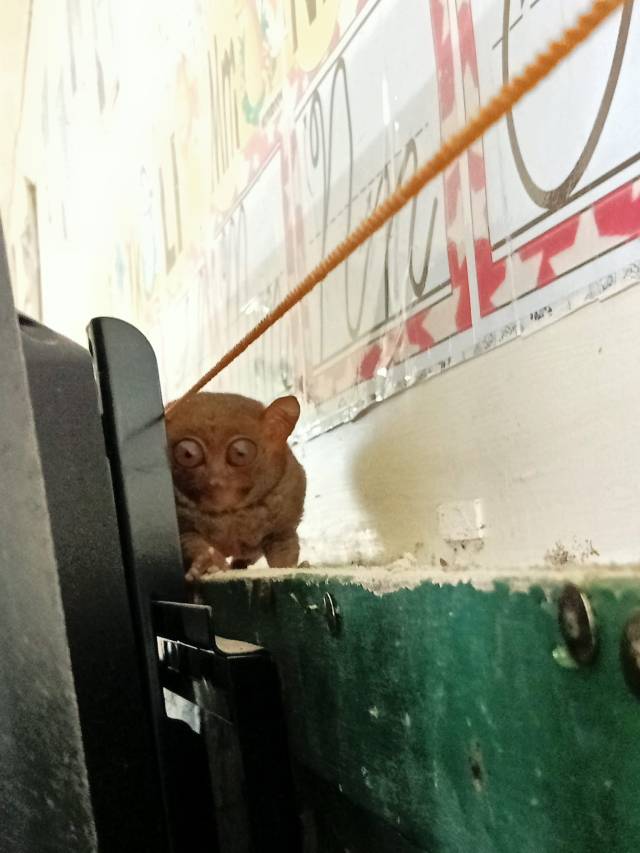
CITY Councilor Jay Pascual yesterday called for community participation to protect the Philippine Tarsier (Carlito syrichta), considered the world’s smallest primate after several instances the villagers themselves have found and rescued on separate occasions in at least six remote villages in Cagayan De Oro City.
Pascual said the latest incident took place inside a classroom of Cadayonan Integrated School in Barangay Besigan where the primate was hiding behind a television unit early this month.
“Villagers should be aware that it is prohibited to catch Tarsier and to come to be their pet, “ said Pascual.
Pascual, who is the chair of the City Council’s committee on tourism is now seeking the support of the community and the local environmental department in the preservation of the Tarsier following it was categorized by the International Union for Conservation of Nature Red List of Threatened Species.
“This is our focus now to raise awareness of the people, especially in communities living near the said six barangays where the natural habitat of some of our endangered species like Tarsier lived in,” Pascual said in an interview.
He said all the rescued tarsiers were found healthy and released in forested areas where they were found.
“I saw the captured tarsier,” said Pascual adding the primate’s photo was even posted on social media, and it went viral.
Engr. Armen Cuenca, the City Local Environment and Natural Resources Office (CLENRO) head said the city government has already planned for the said identified areas to be under their biodiversity monitoring site.
Based on DENR Administrative Order 2019-09 or the updated national list of threatened Philippine fauna and their categories, the Philippine Tarsier is categorized as an “Other Threatened Species”.
This means, according to Cuenca that the species is under threat from adverse factors such as over-collection and is likely to be moved to the vulnerable category soon.
He also confirmed that Tarsiers are frequently sighted by villagers in the said upland barangays.
“Vulnerable species are considered to be facing a high risk of extinction in the wild,” said Cuenca.
Under R.A. 9147 or the “Wildlife Resources Conservation and Protection Act,” it is unlawful for any person to willfully and knowingly exploit wildlife resources.
During the regular session, Pascual said, he experienced another Tarsier that was rescued by a concerned citizen and he advised to turn it over to the provincial environment office in Misamis Oriental in order the tarsier back to its natural habitat.
At first, the councilor said he did not believe in their existence in our locality until a kid at Sitio Man-ai brought him one of the primates placed in a small cage.
As a pet lover himself, he was instantly touched by the primate’s eyes peeping thru the bars that he ordered it to be released right away as he always despises cruelty and caging of animals.
It was turned over to the DENR, but the according to Pascual he does not know what has happened to the primate, adding he only hoped the agency has a preservation program in saving the save.
With this turn of events, Pascual said that Cagayanons now know that these primates are not only found in Bohol but also here in the city, particularly in barangays Tignapoloan, Bayanga, Mambuaya, Dansolihon, and just recently in Belgian.
Based on Administrative Order No. 2019-09 or the Updated National List of Threatened Philippine Fauna and Their Categories, the Philippine tarsier is classified as a threatened species.
“WE all live on this beautiful earth where disturbing our ecosystem will trigger a big effect once we do not protect its inhabitants,” said Pascual.
There are 5,000 to 10,000 remaining tarsiers in the country but the group International Primate Protection League said the number is dwindling as the wildlife is facing multiple threats to its existence due to low birth rates, exploitative tourism, and habitat degradation from extractive activities such as logging and mining.
As deemed the world’s smallest primate, this 45-million-year-old species faces a triple threat to its existence namely, low birth rates, explorative tourism, and habitat destruction, according to Pascual.
It also tends to commit suicide when they are locked up or kept in a cage. Since they only eat small insects in the wild, it’s hard to keep one as a pet because they easily die in captivity, Pascual further said.
Pascual added that based on the study, there are about 13 species of tarsiers in different parts of the country. However, there are only five to ten thousand left in the wild.
“I know for a fact that tarsiers are protected by law, but my prayer is for the DENR, CLENRO, City Vet, and the DepEd to work together hand-in-hand in doing a preservation program in saving the tarsiers and to learn about tarsiers from our neighboring municipality of Bohol,” Pascual said.
As requested, the matter was referred to the committees on environment and education for further study and deliberation.
Disclaimer
Mindanao Gold Star Daily holds the copyrights of all articles and photos in perpetuity. Any unauthorized reproduction in any platform, electronic and hardcopy, shall be liable for copyright infringement under the Intellectual Property Rights Law of the Philippines.










